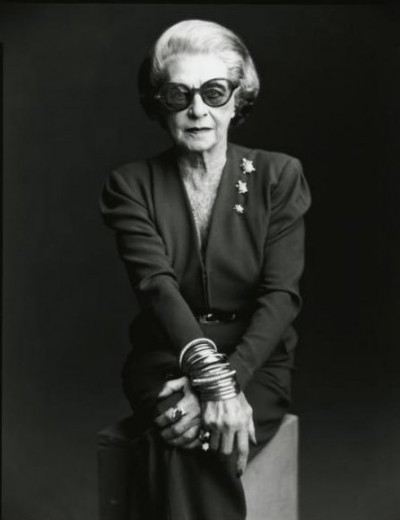
Pauline Trigere
About
Pauline Trigere was a French-born American fashion designer, known for her crisp, tailored cuts and innovative ideas.
Pauline Trigere was born in Paris, France in 1909 to Russian Jewish émigré parents. She knew how to operate a sewing machine by the age of 10 and assisted her dressmaker mother. Her father was a tailor who had made military uniforms for the Russian aristocracy and her mother was a dressmaker. Pauline grew up in an atmosphere of fine tailoring.
When she was a teenager, lack of money prompted her to make a dress for herself. It was plaid taffeta, its collar had 3 layers of organdy edged with red, green and blue piping. For fun, she made a copy of this dress in 1971.
The Look
Trigere's own elegance and Gallic charm, were renowned as was her favourite method of keeping fit - standing on her head. She wore her own clothes, adding printed scarves, tied her own way and with her own collection of handsome jewellery including her signature turtles, which she pinned on a shoulder or a cuff. She worked by cutting and draping bolts of fabric. She was known for her crisp, tailored cuts and innovative ideas, particularly with outerwear. She is credited with the introduction of removable scarves and collars from dresses and coats. Trigere also created dresses with jewelry attached, sleeveless coats, reversible coats and opera capes. One of her capes is made from black blanket wool and angora reversible to a shocking pink. Many of her coats are designed to be worn with two interchangeable dresses. Fur trims appear often on her garments. Trigere was one of the first designers to use wool for evening wear. Pauline Trigére was more than a designer of women's clothing, she was a fabric artisan. During the 1940s Trigére become known especially for her impeccable and imaginative tailoring of women's suits and coats. She made use of all weights of wool, from sheer crepes for eveningwear to thick tweeds for daytime coats. She was recognized early in her career as an innovator for such fashions as evening dresses made of wool or cotton, reversible coats and capes in all shapes and sizes. Another characteristic Trigére feature is the luxurious touch of fur trim at necklines, cuffs, and hems. Before the 1960s, her palette was fairly subdued and she rarely used printed fabrics; during the 1960s and 1970s she began to use more prints and softer fabrics, always retaining a tailored touch. Her use of prints is bold and deliberate, the pattern is often used to complement the structure of the piece. Notwithstanding her extensive use of wool and tailoring techniques, Trigére's clothing has always been unmistakably feminine. While she was an acknowledged innovator of fashions, she was also known for repeating and perfecting her most successful themes. For example, her princess line dress has consistently been considered to have no equal, and her rhinestone bra top, first introduced in 1967, was revived in 1985 and again in 1992. Throughout the evolution of fashion in the six decades, Trigére worked within the mainstream while retaining her signature style. Simple elegance and timelessness are descriptions often applied to her work, but style was not her only concern. She insisted on the highest quality of materials to assure her clothing served her customers for years to come. Her collections were carefully planned so many pieces worked together, and complement past seasons' collections. Trigére's work has been compared to that of two legendary French couturiers, Cristobal Balenciaga and Madeleine Vionnet. These designers were known for employing complex and unusual construction techniques to create simple, elegant silhouettes. Trigére herself rarely sketched her ideas; like Balenciaga and Vionnet she designed by draping and cutting the actual fabric on a dress form or live model. The fabric itself is an important part of Trigére's design process; it is her inspiration and her guide as it reveals what it is capable of doing. Trigére's continued involvement with the creative process and her insistence on quality made her unique on New York's Seventh Avenue.
Who Wears It
Duchess of Windsor, Claudette Colbert, lena Horne, Wynona Ryder,